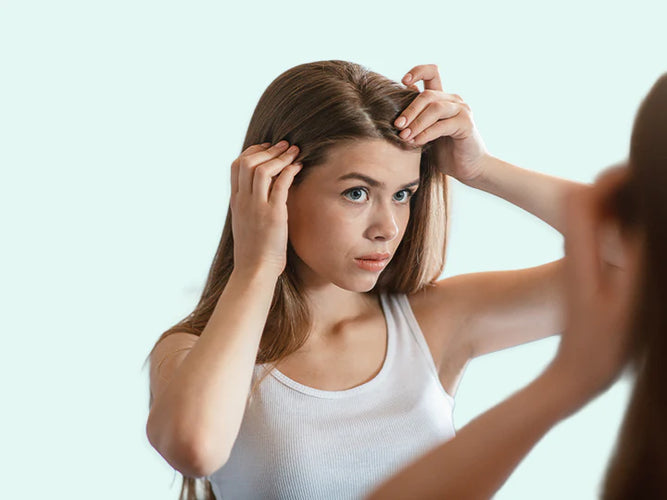Do you increasingly notice in the morning that your scalp is visible, even after your hair has dried? We understand this can be alarming, but do not worry, it is very common to see your scalp through your hair. A visible scalp can have many causes. Fortunately, there are several ways to improve or camouflage it. Here, we explain how to recognize it and what you can do, from medical treatments to styling tips.
Why can I see my scalp through my hair?
You can see your scalp because your hair is thinning or shedding. Everyone loses around 50–100 hairs a day, but normally new hairs grow back. If the shed hair is not fully replaced by new growth, you gradually end up with less hair volume. Individual hairs may regrow finer and shorter (as in hereditary hair loss), or you may temporarily shed many hairs at once (telogen effluvium). As a result, the scalp becomes visible through the hair.
Why does your hair look thinner and your scalp more visible?
There are several reasons why your hair can become thinner and your scalp more noticeable. Sometimes the thinning is temporary. It can also differ partly between women and men. Let’s look at the main causes:
Most common causes in women
• Hereditary hair loss: This often develops after the menopause, and around 30% of women experience it later in life.
• Hormonal fluctuations: Shifts in hormone levels can trigger (temporary) increased shedding: for example, after pregnancy.
Want more in-depth information? Read our blog on female hair loss.
Common causes in men
• Androgenetic alopecia: This is hereditary hair loss and the most common cause of thinning hair in men. It is known as male pattern baldness. The process is driven by the hormone DHT, which makes hair follicles more sensitive and causes them to shrink gradually. With each hair growth cycle, the hair becomes shorter and finer, and eventually some follicles stop producing new hairs altogether.
Want more in-depth information? Read our blog on male hair loss.
Temporary causes of thinning hair
Sometimes you notice your hair is getting thinner, but it is only temporary. For example:
• Telogen effluvium: A temporary form of hair loss that often occurs after a period of stress or a major event. More hairs than usual shift into the “resting” phase and shed within a few months. You typically notice this 2 to 4 month after the trigger, for instance after a severe flu with fever, surgery, childbirth or an emotional shock. The shedding is diffuse across the scalp, which can make the scalp more visible. The good news: this type is usually temporary, as your body or mind recovers, hair often regrows. Want to know more? Read our blog on telogen effluvium or view our telogen effluvium treatment.
• Hormonal changes after pregnancy: Many women experience significant shedding around 3 months postpartum (postpartum alopecia). During pregnancy, oestrogen levels are higher; after birth they drop, which can cause hairs to shed in larger numbers. This postpartum shedding usually begins a few months after delivery and typically lasts up to around 6 months; by the baby’s first birthday, most mothers’ hair density has returned to normal.
• Nutritional deficiencies: Your body may be missing key building blocks such as iron, vitamin D or biotin, which can contribute to thinning. The good news is that correcting deficiencies can help.
• Medications: Some medicines list hair loss as a side effect, for example certain blood thinners, high-dose vitamin A or beta-blockers. If you stop the medication in question, hair usually regrows within a few months, unless the follicles have developed scarring or permanent damage.
• Seasonal shedding: Do you notice more hair fall in late summer or autumn? That can be the case. Some studies suggest people shed more at these times of year. This, too, is temporary in nature.
How do you recognise thinning hair at an early stage?
Hair loss often happens gradually. The earlier you notice it, the more you can do to slow it down. Watch for these signs:
In women
• Your parting is getting wider.
• You have less volume at the crown, so your hair looks flatter.
• Your ponytail is thinner.
• You find more hairs on your brush, in the shower drain or on your pillow.
• Your scalp is visible in bright light.
Dermatologists use the Ludwig scale to assess hair loss in women

In men
• The recessions at your temples are slowly getting bigger.
• You develop a bald spot on the crown (vertex) that looks shinier.
• Your hairline recedes into an M-shape.
Dermatologists use the Norwood scale to assess hair loss in men

Other early signs
• You are shedding a lot of hair on your pillow or in the shower.
• Short, fine “baby hairs” along the hairline.
Tip: Take a photo of your hairline and crown every couple of months. This helps you spot changes sooner. If in doubt, have your scalp checked by a dermatologist.
What can you do about visibly thinning hair?
There are several ways to address this issue. The best approach depends on the cause and the severity of the problem. Think in terms of professional medical treatment, using specific products, and making lifestyle adjustments. Here are the options:
Professional treatments
If you are dealing with persistent or significant thinning, professional help can make a real difference, though it does come with a cost. First consult a dermatologist or hair specialist for a proper diagnosis. They can rule out underlying causes and advise an appropriate course of treatment. Possible options include:
• Low-Level Laser Therapy (LLLT): the red light used in this treatment can help stimulate hair growth.
• Hair transplantation: healthy hair follicles are moved to areas with hair loss.
• PRP therapy: growth factors from your own blood are injected into the scalp.
Every treatment has its limitations and may not work equally well for everyone. Always discuss with your doctor which approach is most suitable for you.
Clinically proven ingredients
Do you find professional treatment too expensive? There are also more affordable options to address hair loss. Consider specialised products or treatments for hair loss, such as the Neofollics Thinning hair treatment. This can be a good option for preventing further hair loss. Patience is key here. With consistent use (and depending on the individual), you may see the first results after 3 to 6 months.
Lifestyle and nutrition approach
Your lifestyle plays a major role in your hair’s health. A healthy lifestyle can slow hair loss. Consider the following:
• A balanced diet is important. Hair is largely made of protein (keratin), so make sure you eat enough protein.
• Complement this with vitamins and minerals that can support hair growth, such as vitamins A, B7 (biotin), C, D, E, iron, zinc and omega-3 fatty acids.
• Deficiencies can contribute to hair loss; correcting them can improve hair density. Eat a varied diet with vegetables, fruit, whole grains, nuts and protein-rich foods.
• If you suspect a deficiency, get a blood test and use supplements only in consultation with your doctor.
• Reducing stress can also help. Long-term stress can trigger hair loss. Make time for relaxation, get enough sleep and exercise regularly.
• Stopping smoking is beneficial, as smoking can accelerate hair loss.
• Good hair care helps prevent additional damage. Use gentle, preferably sulphate-free shampoos.
• Avoid hot water, daily heat-styling and tight hairstyles that pull on the hair.
• Brush gently, especially when your hair is wet.
Pay attention to changes. Sudden or severe hair loss may indicate a medical issue, such as a thyroid disorder or a vitamin deficiency. If in doubt, always consult a doctor. Sometimes hair grows back once the underlying cause is addressed.
Styling tips to make your scalp less visible
With these styling tips, you can effectively camouflage thinning hair.
• Choose the right haircut: For women, a shorter cut with layers can create the look of more volume. For men with a thinning crown, a shorter style also works better, it reduces the contrast between hair and scalp.
• Consider a different hair colour: If you have dark hair and a light scalp, your scalp will show through more. Colour your hair closer to your skin tone to reduce this contrast, for example with highlights or lowlights.
• Use volumising products: If you like heavy gels or waxes, consider easing off if you want less scalp show-through. Lightweight, volumising products give more grip and lift the hair slightly, so it sticks less to the scalp. Think volumising mousse, texturising spray, dry shampoo or hair powder.
• Shift your parting: Do you wear a centre parting where the hair is thinner? Try a side parting instead. You can also experiment with a messy zig-zag parting. For extra lift, apply a volumising powder at the roots along the parting.
• Camouflage with hair fibres or sprays: There are special hair-camouflage products that create the look of fuller hair, such as keratin hair fibres. These microscopic fibres cling to your hair and tint the scalp to match your hair colour.
• Accessories or hairpieces: You can always opt for temporary aids, such as modern hairpieces, which can look very natural and give instant fullness. Hats, caps, scarves or headbands can also be stylish while discreetly concealing the scalp.
Conclusion
Many men and women have a visible scalp, often due to thinning hair. Fortunately, there is usually something you can do. First, identify why your hair is thinning, for example, hereditary factors, hormones, stress or something else. Causes can differ between men and women. A doctor or dermatologist can determine the cause and advise on treatments. The earlier you act, the better the results tend to be.
Happily, there are plenty of solutions. Medically, you might consider innovative treatments such as PRP or, in advanced hair loss, a hair transplant. There are also care products on the market (such as the Neofollics thinning hair treatment) that combine multiple scientifically supported ingredients to help counter hair loss.
You can also do a lot yourself: adopt a healthy lifestyle, address deficiencies, reduce stress and look after your hair and scalp. And do not forget the cosmetic side. With the right cut, products and techniques, you can often style thinning hair so that no one notices your scalp.
Sources
Blissy. (n.d.). My Hair Is So Thin I Can See My Scalp: Steps to Boost Hair Density. Retrieved August 12, 2025.
This information does not replace professional medical advice. If in doubt, always consult a doctor or specialist.













